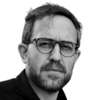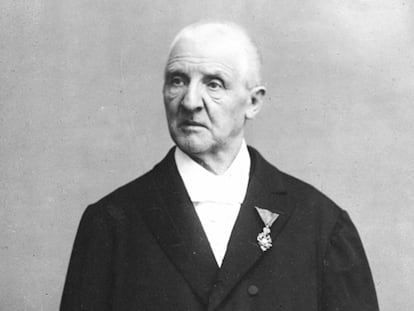Schönberg and Kraus: the noisy charm of a dissonance that took on the world
It’s the 150th anniversary of the birth of both the master of atonal music and the fierce editor of ‘The Torch.’ Vienna’s Arnold Schönberg Center brings the two together in a magnetic exhibition that commemorates their defiance of convention

Over a century ago, Viennese composer Arnold Schönberg started a musical revolution. Critics weren’t shy about weighing in on his innovative sound. “If this way of making music becomes accepted, I hope that death will deliver me from hearing it” (The New York Times, 1913). “15 brave musicians presented us with Schönberg’s Chamber Symphony, which, without a doubt, would be deserving of the title of Symphony of chamber-of-horrors” (Signale, Berlin, 1913). “All performances of his works in Austria and Germany have led to riots, criminal charges, hospital admissions of the wounded and corpses in the morgue” (Paris-Midi, 1913). “A respectful and well-meaning public instantly burst into laughter” (The Boston Post, 1914). “The name Schönberg, as far as the British public was concerned, meant nothing but garbage” (Musical Times, London, 1930).
Such critiques were collected long ago by composer Nicolas Slonimsky, but read aloud much more recently in the Viennese museum that treasures Schönberg’s artistic legacy (which is protected by UNESCO) and according to one of the greatest experts on his work, Therese Muxeneder, they sound even more dissonant today. “They were witnessing a musical revolution in which there was no gray scale. With Schönberg, everything was black and white — what classical music concert could provoke such disturbances today?” asks Muxeneder, who gestures at a glass case with the original program from March 31, 1913. On that day, in the golden hall of the Musikverein, the musical temple that annually hosts the illustrious New Year’s Concert, and where the audience hardly dares to clap when the bars of the Radetzky March are played, the concert was cancelled before its fifth piece, Gustav Mahler’s Kindertotenlieder, could begin. When Schönberg, who was conducting the orchestra, launched into the score by one of his disciples, Alban Berg, the booing and jeering and exchange of blows between supporters and detractors of the avant-garde began. The cerebral composer Anton Webern shouted from his box to the rows below, “out with the rabble!” The Skandalkonzert concluded in the police station and in a lawsuit between four of its spectators. The Paris-Midi critic was hyperbolizing, but he knew what he was talking about.
On the occasion of a shared anniversary, the 150th year since the births of Schönberg and Karl Kraus, Muxeneder is presenting a brilliant exhibition in the Arnold Schönberg Center that explores the two intellectual’s common cause against the established order. Kraus was the literary guru of the composer who pioneered atonality and dodecaphonism. “I have perhaps learned more from you than one is permitted to learn if one wishes to remain independent,” he confessed to Schönberg in a letter, “Your style has taught me how to write and almost how to think.”
Kraus nearly single-handedly edited and wrote the magazine Die Fackel (The Torch) between 1899 and 1936. He published 22,578 pages over a total of 922 issues that established themselves as a force of intellectual subversion. Beyond Offenbach and the distraction of operettas, he ignored music, did not appreciate atonal experimentalism and did not attend concerts, but in a speical spot in his cabinet, he kept the self-portrait of Schönberg that the composer had sent him. Above all, he employed his caustic prose as the musician’s ally: a month after the Skandalkonzert, he wrote a scathing attack on the Vienesse press in Die Fackel that accused it of “finally falling below the level that made it contemptible for so long” in its defense of the concert’s troublemakers.
Their relationship never became a friendship. Nonetheless, Schönberg was not only inspired to write essays, theoretical reflections and aphorisms by their connection, some of his compositions were also influenced by it. Literally, its impacts could be heard in his voice. In the composition of his atonal piece Pierrot Lunaire (described by New York critics as the ultimate in cacophony and musical anarchy), he was inspired by Kraus’s powerful baritone timbre as a tool of artistic expression. The publisher programmed recitals of selected texts to launch his magazine, in which its satire was amplified as in a Wagnerian cabaret by his own vocal registers.

For a Viennese artist, it was nearly impossible to escape Die Fackel’s seductive influence. The attraction that Schönberg held for the vanguardists is documented in oil on canvas: he was captured by contemporary painters in three different decades, Richard Gerstl (1905), Max Oppenheimer (1909), Egon Schiele (1917) and Oskar Kokoschka (1924). In the exhibition, which receives visitors with its protagonists’ death masks, various paintings by the composer are on display, proof of his own experimentations with the medium.
On another wall hangs the lithographs that Oskar Kokoschka, a good friend of both men, made to illustrate Kraus’s essay The Great Wall of China, which was published by Die Fackel in 1909. Here too are musical scores, letters from Alma Mahler and memorabilia, such as Schönberg’s small phone book (Kraus’s phone number is marked as 7857) and the document proclaiming his reconversion to Judaism in Paris, with the signature of painter Marc Chagall as witness. In 1933, he rehearsed a satirical composition ridiculing Hitler, orchestral variations on Horst-Wessel-Lied, the Nazi Party anthem. “He was a visionary,” says Muxeneder. “In his manifesto A Four-Point Program for the Jews, which was preceded by an intensive study of the Hebrew population in Europe, Schönberg predicted the genocide of European Jews in 1938.”
He took refuge in Los Angeles, where the news reached him, like a funeral procession, of the death of Kraus and Schönberg’s disciples Alban Berg and Webern, with whom he had formed the Second Viennesse School. Webern’s demise had been dramatic. He was shot by an American soldier in Salzburg during the Allied occupation in 1945, when the war was already over. The soldier had been part of a patrol who was chasing a black-market dealer, came across the musician and in the confusion of the night, shot Webern dead.
The Californian exile coincided with Thomas Mann, who was inspired by Schönberg’s dodecaphonism to write his novel Doktor Faustus. The writer feared the possibility that the composer would sue him and demand his intellectual property rights. The resemblance was all too real, except for the small detail: the character suffered from syphilis.
Like Kraus, Schönberg kept a framed portrait of his colleague in his Los Angeles study, a piece that is now in Vienna. Schönberg made the oil painting in 1910 and it is entitled Satire (Karl Kraus).
Sign up for our weekly newsletter to get more English-language news coverage from EL PAÍS USA Edition
Tu suscripción se está usando en otro dispositivo
¿Quieres añadir otro usuario a tu suscripción?
Si continúas leyendo en este dispositivo, no se podrá leer en el otro.
FlechaTu suscripción se está usando en otro dispositivo y solo puedes acceder a EL PAÍS desde un dispositivo a la vez.
Si quieres compartir tu cuenta, cambia tu suscripción a la modalidad Premium, así podrás añadir otro usuario. Cada uno accederá con su propia cuenta de email, lo que os permitirá personalizar vuestra experiencia en EL PAÍS.
¿Tienes una suscripción de empresa? Accede aquí para contratar más cuentas.
En el caso de no saber quién está usando tu cuenta, te recomendamos cambiar tu contraseña aquí.
Si decides continuar compartiendo tu cuenta, este mensaje se mostrará en tu dispositivo y en el de la otra persona que está usando tu cuenta de forma indefinida, afectando a tu experiencia de lectura. Puedes consultar aquí los términos y condiciones de la suscripción digital.
More information
Archived In
Últimas noticias
There is as much life left to discover on planet Earth as that which is already known
Dozens presumed dead, around 100 injured in fire at Swiss Alps bar during New Year’s celebration
Is porn for women different from conventional porn? We spoke to those who make it
Cartagena de Indias is sinking: What can the city do to mitigate it?
Most viewed
- Sinaloa Cartel war is taking its toll on Los Chapitos
- Reinhard Genzel, Nobel laureate in physics: ‘One-minute videos will never give you the truth’
- Oona Chaplin: ‘I told James Cameron that I was living in a treehouse and starting a permaculture project with a friend’
- David King, chemist: ‘There are scientists studying how to cool the planet; nobody should stop these experiments from happening’
- Why the price of coffee has skyrocketed: from Brazilian plantations to specialty coffee houses











































